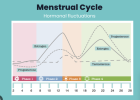I think you may have missed my point. I thought I was clear. I am saying that the researchers here did not gather crucial information about the participants in this study e.g. menopausal, having regular periods, taking hormonal contraceptives. They did not ensure that samples were taken at the same time in the menstrual cycle.
I don't think that is true. We know that oral contraceptives fundamentally change hormonal levels. They do that because they have to change an aspect of the way the female body works, to make it not fertile.
We know that hormonal levels vary greatly during the menstrual cycle.
So, if in one sample you have 50% of the females taking oral contraceptives, and 30% were sampled during their period, and, in the other sample, only 10% of the females were taking oral contraceptives and only 10% were sampled during their period, then the average ratio of various hormones for the cohorts will be substantially different.
I do understand this, and I am sure that securing more funds was a major motivation for publishing the study. And, that is a big part of my concern here.
The researchers have said 'Hey, here is a problem! Please give us money to study it further.' And yet, you have not established that there really is a problem, because the participants were not adequately characterised. You have drawn conclusions that may or may not be true. We cannot know if the finding is true at this point. This study's abstract makes the case for studying hormones in ME/CFS more compelling, and may result in other studies that perhaps are more likely to bear fruit being delayed.
I might try use an analogy to help. If one car in traffic breaks down then the cars behind it are also stopped in their progression. This outcome highlights a relationship in progression. This is relevant to OCP impact on controlling steroid production. Even in this instance you expect relationships to be maintained to a degree that it's statistically significant. What you are arguing is why us saying that we didn't see differences in cortisol or other steroid levels between ME and controls is weak. I agree, without accounting for the factors you highlight it's not going to be rigorous enough to say we can rule out cortisol belong low in ME because we found no such change.
Track record is a major reason everyone publishes every paper, it's the only way to survive in academia, it's why so few researchers exist in ME/CFS and such little research gets done (it's hard to build a track in this field). You are concerned we are trying to secure grants to do more research? Why? That doesn't make sense to me.
Last edited:



